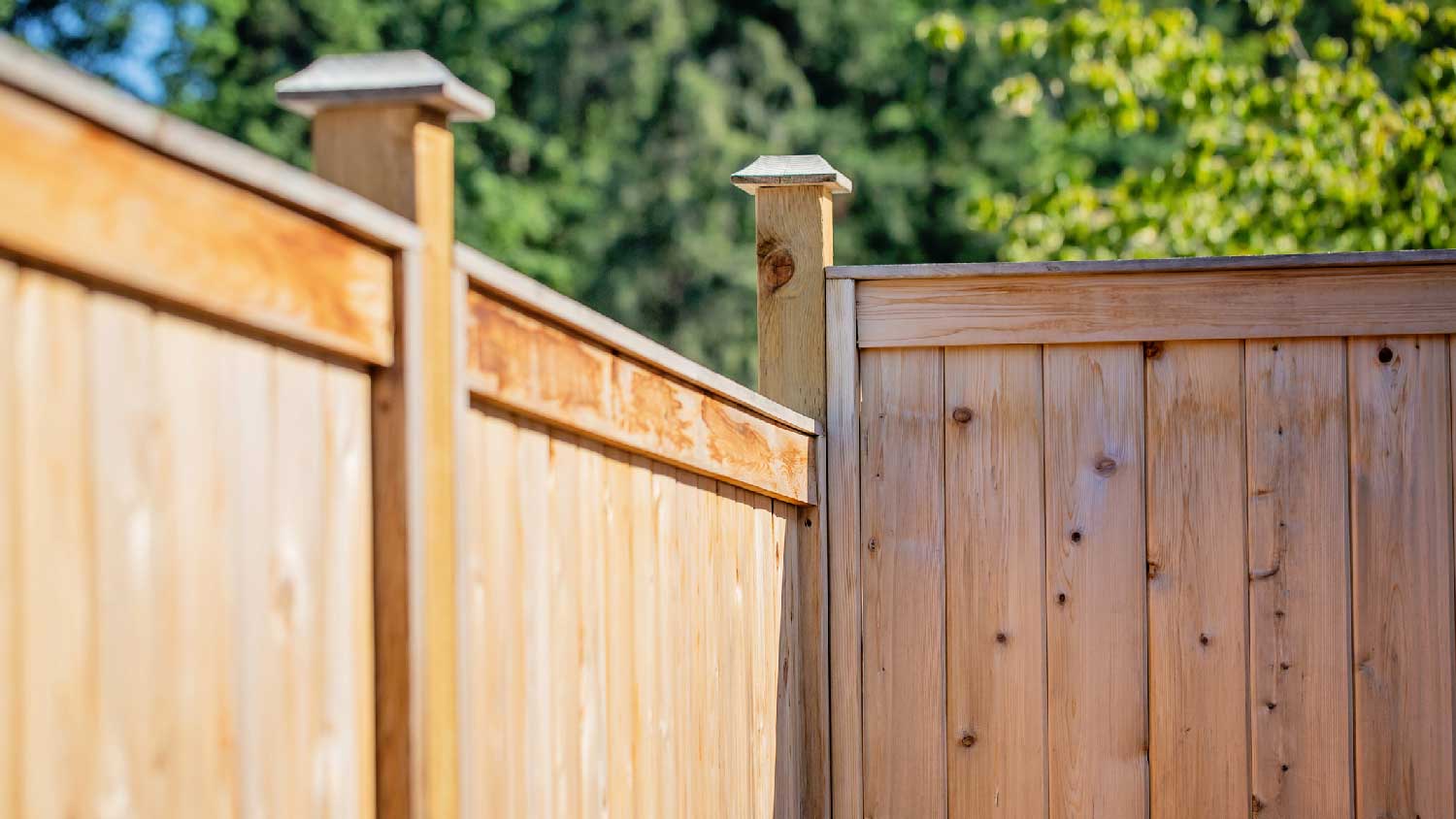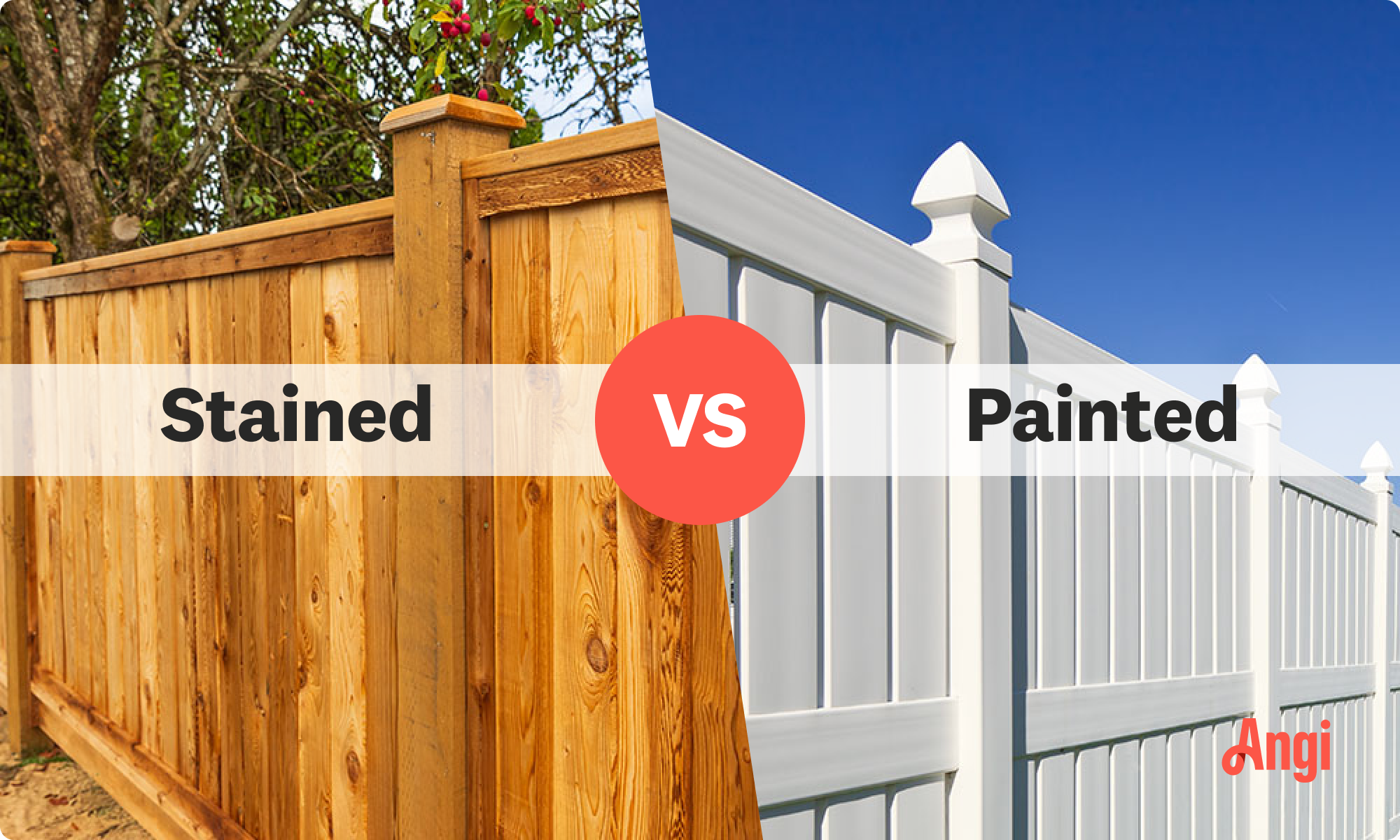
Get expert insights on wrought iron railing repair cost, including average prices, key cost factors, and tips to save on your next project.
Fencing service costs depend on your project and location. Check with a local pro for your specific job.
The type of wood you choose is a big cost factor—cedar, pine, and red cedar are the lowest-cost options.
If you need to remove an old fence first, you’ll pay $300 to $750 extra.
You need to stain or paint your fence for durability and weather resistance, which adds $1,700 to the total project cost on average.
Board on board fences provide the ultimate privacy, but because they use more materials and require more complex installation, they’re among the most expensive privacy fences. On average, a board on board fence costs {{nationalAvgCost}}, but depending on the size of the yard and the type of wood you choose, you could spend anywhere from {{nationalMinCost}} to {{nationalMaxCost}}.
To estimate the cost of a board on board fence, the easiest thing to do is take the material and labor costs to install a fence and increase them by 30%. That’s because you’ll need about 30% more pickets, posts, and other materials, and the labor will also take roughly 30% longer because the installation is more involved.
The table below shows the typical cost of a wood fence (both materials and labor) and increases it by 30% to give you the typical price range for board on board fences: $15.50 to $52 per linear foot.
| Title | Cost |
|---|---|
| Typical Wood Fence Material Costs | $10–$15 per linear foot |
| Typical Wood Fence Labor Costs | $2–$25 per linear foot |
| 30% average price increase | |
| Board on Board Fence Material Costs | $2.50–$32.50 per linear foot |
| Board on Board Fence Labor Costs | $13–$19.50 per linear foot |
| Total Board on Board Fence Cost | $15.50–$52 per linear foot |
Given that the length of the fence (the perimeter of the land you’re enclosing) directly impacts how much wood and other materials you purchase and how long it takes a skilled fence installer near you to construct the fence, we can estimate the typical cost of a board on board fence by size.
The table below shows how the length of your fence can impact the cost range. Keep in mind, if you’re fencing in multiple acres of land, your costs can go significantly higher.
| Perimeter of Board on Board Fence | Cost Range to Install |
|---|---|
| 50 | $775–$2,600 |
| 75 | $1,162.50–$3,900 |
| 100 | $1,550–$5,200 |
| 150 | $2,325–$7,800 |
| 200 | $3,100–$10,400 |
| 250 | $3,875–$13,000 |
| 300 | $4,650–$15,600 |
| 325 | $5,037.50–$16,900 |
| 350 | $5,425–$18,200 |

The type of wood fence materials you choose for your board on board privacy fence can also greatly impact the cost of your fence. Cedar and pine fence boards, for instance, cost as little as $2 per linear foot while tropical hardwoods can go as high as $25 per linear foot.
| Type of Wood | Price Range Per Linear Foot | Board on Board Price Range Per Linear Foot (Adjusted Up 30%) |
|---|---|---|
| Cedar | $2–$8 | $2.50–$10.50 |
| Composite | $6–$10 | $8–$13 |
| Oak | $5–$15 | $6.5–$19.5 |
| Pine | $2–$8 | $2.50–$10.50 |
| Red cedar | $2–$8 | $2.50–$10.50 |
| Redwood | $8–$20 | $10.5–$26 |
| Spruce | $5–$10 | $6.5–$13 |
| Tropical hardwood | $10–$25 | $13–$32.50 |
Not sure which wood to choose? Here are the best woods for fencing.
Other factors beyond size and type of wood can impact the total cost to install a board on board fence, including:
If you’re replacing an existing fence with the board on board fence, you’ll need to remove the old fence first. Usually, the fence contractor you hire can handle the removal and disposal of the old fence and roll that into your overall cost.
Though it varies by yard size and type of fence, the typical cost to remove a fence is $300 to $750.
In most cases, installing a fence requires a permit. The cost is minimal (usually $20 to $60) and is often rolled into the quote from your contractor—though you should always confirm with the contractor that they will obtain the permit and that the cost is already accounted for in the quote.
Where you live can impact both material and labor costs. Coastal areas and cities tend to have higher costs of living than the suburbs and small towns, though you should also expect to pay more if you live in a remote location with less competition among contractors and hardware stores.

You may want to stain or paint your fence after installation, and sealing can help it last longer in the elements. Staining or painting a fence costs an average of $1,700, but this depends on the size of the fence. You may need to hire a local fence painter if your contractor only handles installation, or you can try painting or staining by yourself.
Before beginning any fence installation, you should call DigSafe to be sure there are no underground utilities you have to contend with. If there are, you may need to reroute your fence, which could require additional labor and materials.
The board on board cost ranges above for materials allow for the difference between boards and the more expensive posts, post caps, gates, and other features. But if your fence needs more entry points (i.e., you need to purchase more gates) or you elect for more decorative post caps, your price could go up.
Fence gates are heavy and cumbersome to install. It’s all too easy to make a small mistake and ruin the integrity of your fence during a DIY installation. Hire a fencing pro to ensure a sturdy installation done right.
Board on board fence installation is more challenging than typical fence installation because you must stagger boards to overlap. This turns an already difficult task into a much more laborious endeavor. Unless you have plenty of time to spare and experience building fences, we recommend leaving this one to the pros.
Contractors who specialize in fence construction can build your fence more efficiently and successfully. A well-built fence can attract potential home buyers who appreciate its curb appeal, privacy, and safety for their children and pets, but a shoddily built fence can be an instant turnoff.
Board on board fences are more expensive than the typical privacy fence because of the extra materials and labor required. But that doesn’t mean you can’t find ways to keep costs down. Here are a few ways to save money on a board on board fence:
Choose a more affordable wood: Cedar and pine boards are much more affordable than redwood and tropical hardwoods. Stick to these lower-priced options if you’re building your fence on a budget.
Paint or stain it yourself: If you want to paint or stain your fence, you can cut costs by handling this task yourself. Invite a friend or family member to help, and you can knock it out in a day or two.
Fence in a smaller area: The length of the fence has a direct impact on the overall cost. By fencing in a smaller area, you reduce the material and labor costs. Try to use your home’s wall as one barrier so that you only need to fence on three sides of your yard.
Fences don’t inherently raise the value of your home, at least as far as an appraiser is concerned. That said, home buyers with children or pets may be more likely to purchase a home that has a fence, meaning you might sell your home more quickly. A board on board fence offering heightened levels of privacy can also be appealing.
Home is the most important place on earth, which is why Angi has helped more than 150 million homeowners transform their houses into homes they adore. To help homeowners with their next project, Angi provides readers with the most accurate cost data and upholds strict editorial standards. We extensively research project costs to develop the pricing data you see, so you can make the best decisions for you and your home. We rely on reputable sources, including the U.S. Bureau of Labor Statistics, academic journals, market studies, and interviews with industry experts—all to ensure our prices reflect real-world projects.
Want to help us improve our cost data? Send us a recent project quote to [email protected]. Quotes and personal information will not be shared publicly.
From average costs to expert advice, get all the answers you need to get your job done.

Get expert insights on wrought iron railing repair cost, including average prices, key cost factors, and tips to save on your next project.

Renting temporary fencing will protect your property during construction or even a party. Fence type, material, and security features impact the cost.

Chain-link fences are among the most affordable options available. Use this chain link fence cost guide to see what your fence installation will total.

What is chain link fencing, anyway? Chain link fencing has a lot to offer, so consider this option when installing a fence on your property.

Unsure who to hire to install a wrought iron fence? Compare fence contractors and ornamental iron pros, see how installation works, and choose confidently.

Wondering who to hire to repair a chain link fence? Learn when to call a fence contractor, when a handyperson fits, and how repairs get done.